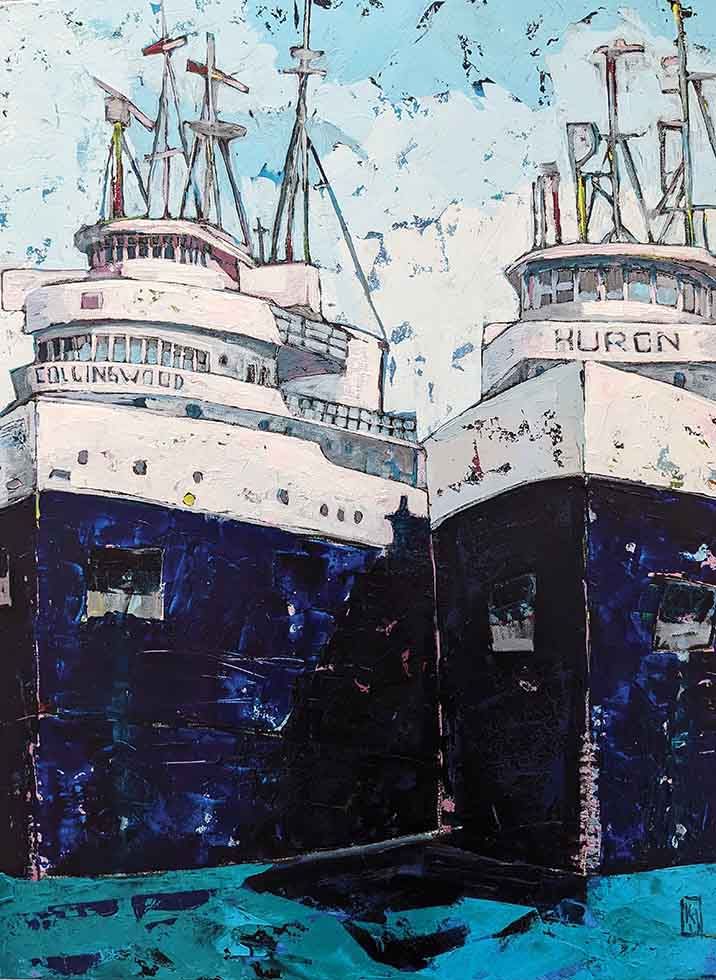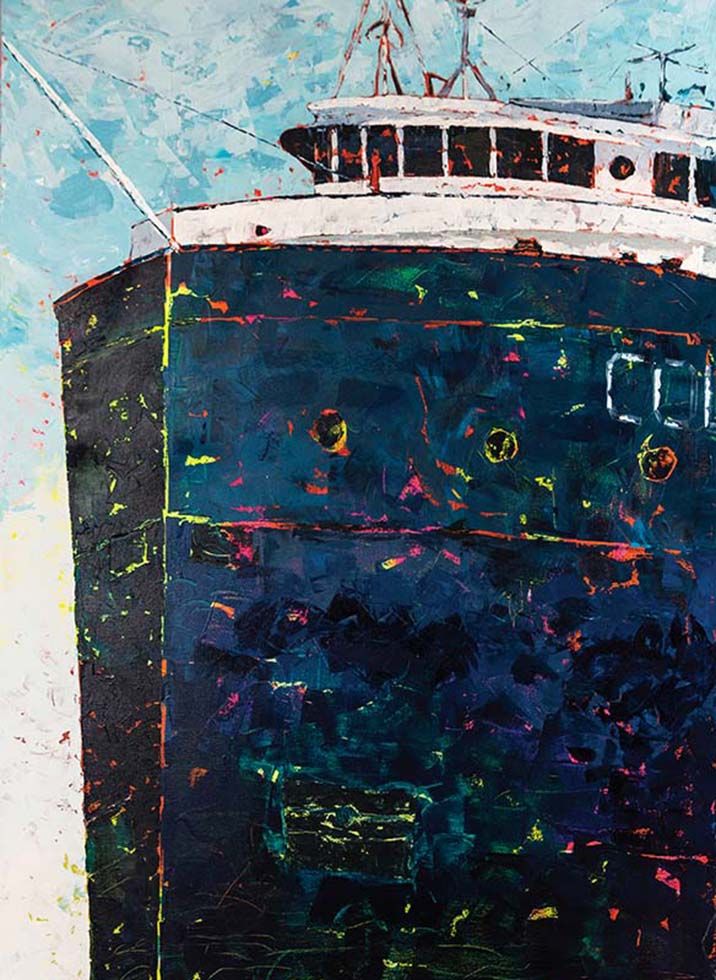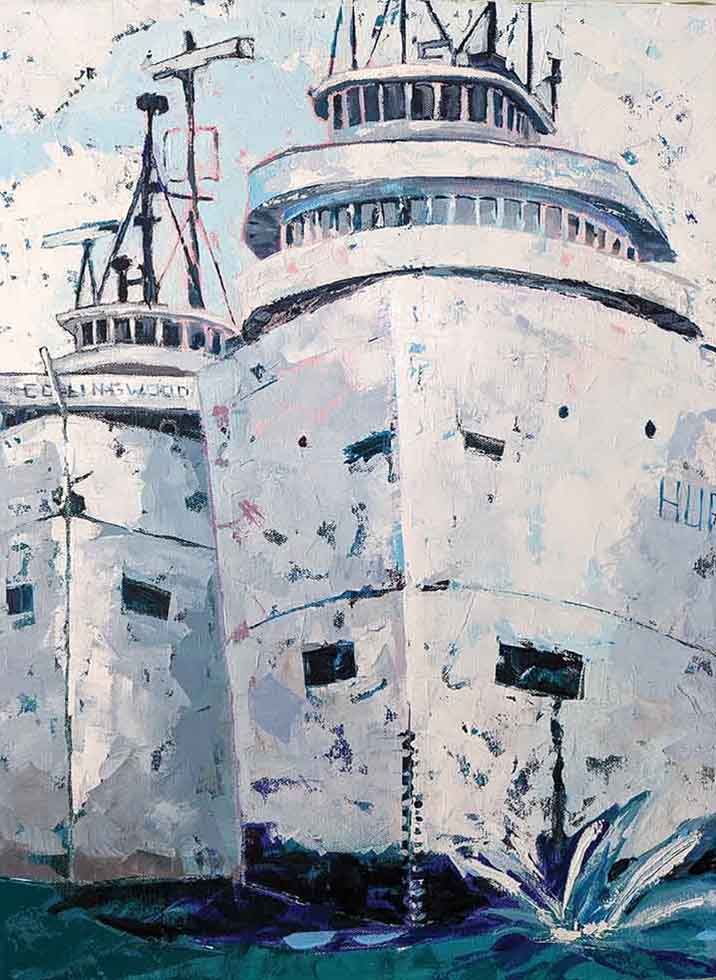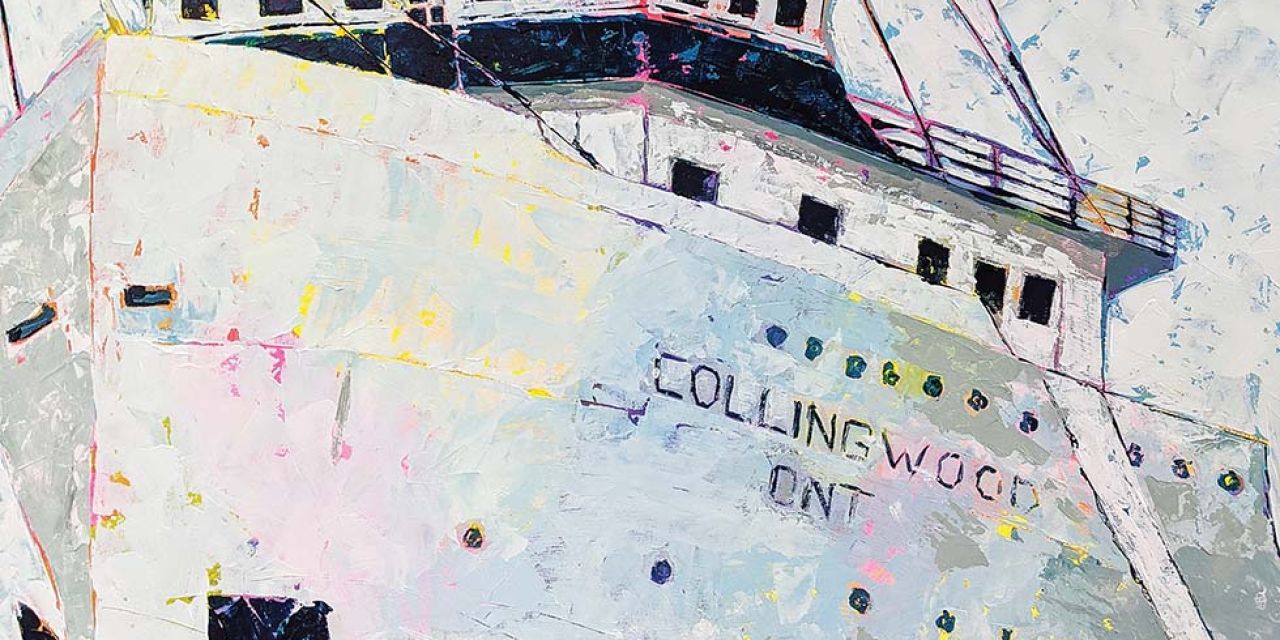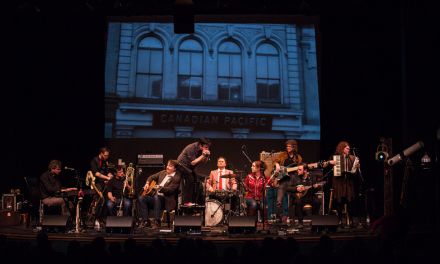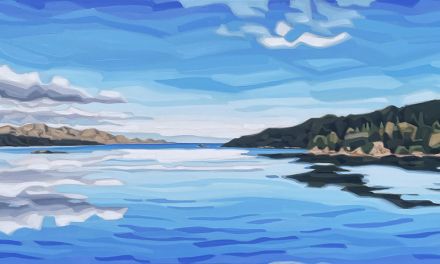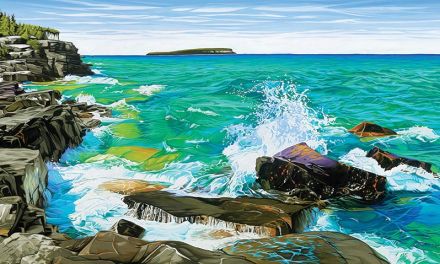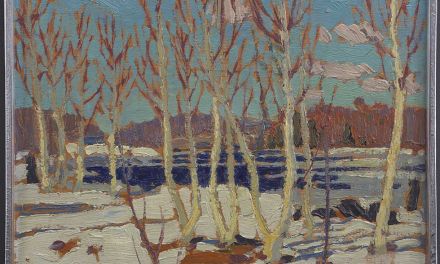Glory Days, Collingwood, 18″ x 24″, acrylic.
HULLS, HISTORY & BRUSHSTROKES
by Kate MacLennan
Collingwood artist Kaz Jones honours our shipbuilding legacy, transforming storied vessels of the Great Lakes through her canvas into a captivating blend of history and personal exploration.
From her studio window in Collingwood’s Tremont, Kaz Jones can see deep into the history of the Great Lakes shipping industry. The view straight out over Heritage Drive is the exact location where the city once boasted its two operating drydocks that helped launch— side launch, actually—the country into the era of steel-hulled vessels. Beyond that are the ever-changing colours of spectacular, volatile Georgian Bay, itself an impressive and intimidating marine sideroad that once connected Collingwood to the industry’s predominant maritime thoroughfare: the St. Lawrence River. The scene brings Jones full circle from her days growing up in England, close to the Manchester Ship Canal.
“I remember seeing ships as a kid. Not vividly, but they’re in my brain somewhere in that industrial, North England background,” she says. “I have a little studio at home, too, right on Wasaga Beach looking right out at the water, and I see all the wild weather. In November, the windows will bend with the wind. When I think about those ships travelling in that incredible water and coming into Collingwood… I wish I could still see them on the horizon, but there’s so few on the lake now.”

Through Thick and Thin, Collingwood, 10″ x 30″, acrylic.
Last year, when the Edwardian-era steamliner the S.S. Keewatin left Port McNicoll to make her way to a new home at the Marine Museum of the Great Lakes, Jones and her husband, Phil Johnston, went out in their 18-foot boat to escort it. “We were so small below this giant, just looking up, and I felt the huge majesty of this enormous steel hull and thought, ‘I have to paint this.’ So, I started researching it and looking at other pictures of the Great Lakes ships,” she says.
She immersed herself in historic references, poring over photos and books, and travelled to Owen Sound to observe ships docked there. The challenge from the outset was to convey the ship’s monumental size on canvas. Jones says she has a printmaker’s eye— she likes to look at things in lines and blocks of colour—and her approach to the series reflects this.
“My canvas is white, and I do a really bright, wild kind of underpainting with bright colour. I work mainly in acrylics as I find them infinitely forgiving, and I’m using acrylic for this work because of its immediacy, fast-drying and great colour.

Avoid The Hens and Chicks, Collingwood,
18″ x 36″ acrylic.
On top of those bright colours I put a sketch of the ship with paint—loosely sketched in—then I kind of mix colours that remind me of rusty old hulls, or the white of the hull, but those bright colours from the underpainting come through, so I get the peeking bits of bright pink or yellow or turquoise. Those bring the painting to life.”
Jones will describe her work as impressionistic, but she also likes to use the word naïve. “I want the pieces to be approachable and almost simple in their distillation of the actual item to what’s represented on the canvas. So, it’s naïve, impressionistic, interpretive, maybe off-kilter and a bit wonky. And that’s kind of the goal. It’s fun, and that’s the representation stuff—the who you are that comes out. I like things a bit different.”
Every painting in the series is a conglomerate of all the ships she’s studied, and she’ll often put Collingwood or Lake Huron on them, to tie them to a region with their names.
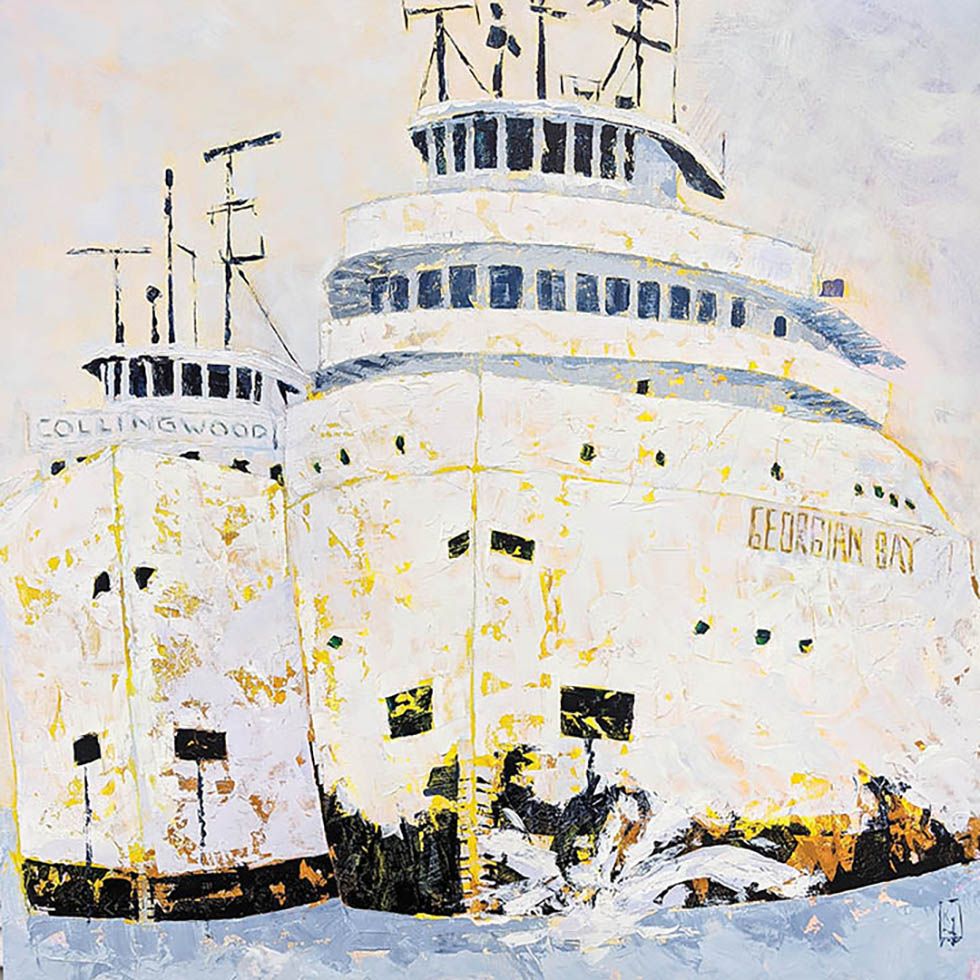
Freighters Full of Gin with a Splash of Lemon, 36″ x 36″ acrylic.
“I like that ships speak to both men and women, but we say ‘she’ referring to boats,” she continues. “I think of the ships as hugely feminine. I think that there’s enormous steel and strength and power behind this feminine thing is really cool. It’s like a recognition, by men, of the power of women—of the reliability and inner peace and strength of a woman.” Perhaps Jones is attracted to these elements in the ships she paints because she subconsciously recognizes them in herself. She certainly has demonstrated such qualities in her life to date.
Born just outside Manchester, England, her family moved to Oakville, Ontario, when she was nine years old. Jones credits her maternal grandfather for her artistic interest. “He was a factory guy who worked at Kellogg’s but I remember colouring pictures with him in an Oliver colouring book. I’d coloured the leaves green, and my grandad said, ‘What if we put some blue and yellow in there, too? There’s a lot more colours there than green.’”
She completed a teaching degree at Queen’s University, then taught in Colombia, South America, for a few years. “I loved the colour and nature and music there—the whole environment. I didn’t have a lot of resources but that’s where I started painting. I would just hang huge pieces of cardboard or paper in the place I was living and use student quality paints and paint big, vibrant paintings. They all got left behind,” she remembers.
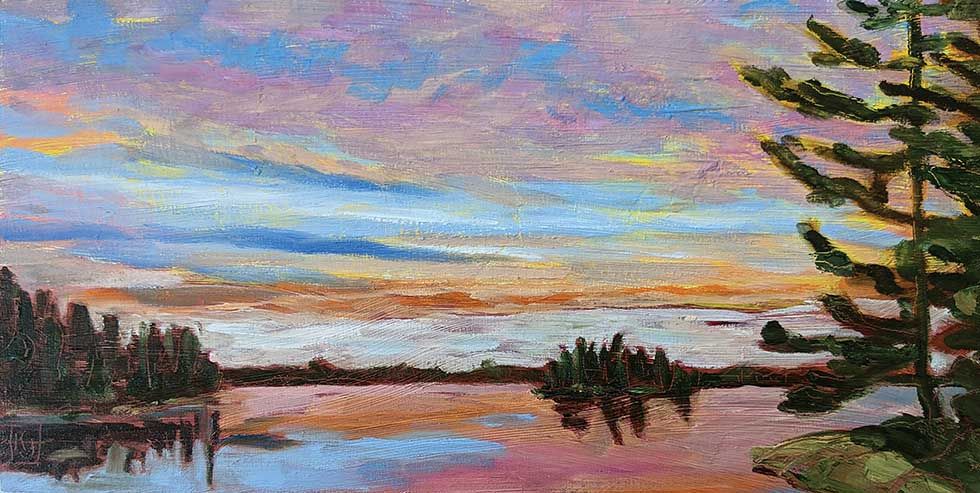
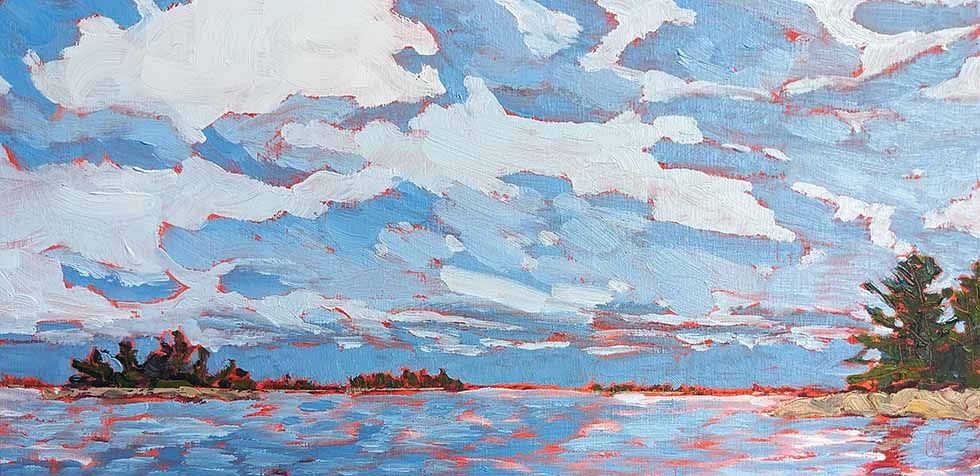
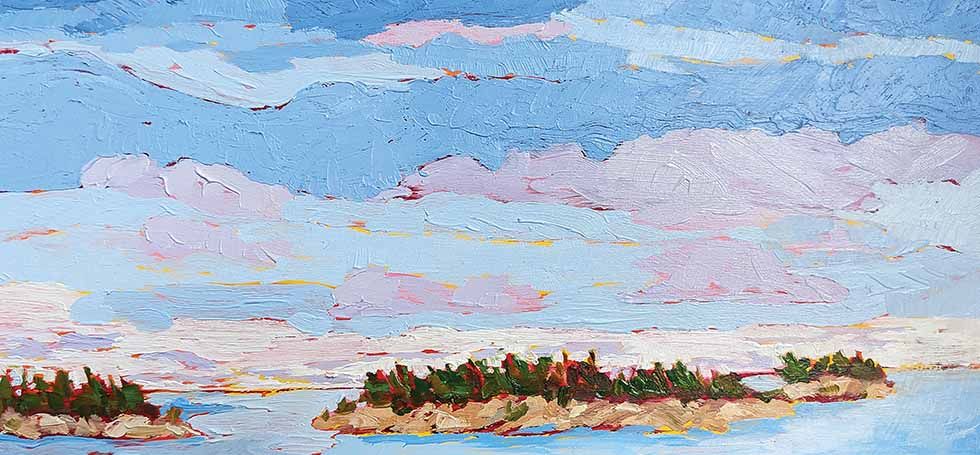
When she moved back to Canada it was to British Columbia, where she lived for five years on the province’s Central Coast in the tiny town of Bella Bella, home of the Heiltsuk Nation, and taught grades one and two. She says that bringing creativity to the curriculum felt natural for her.
“You can teach reading and numbers through art, and I just loved being creative with the kids. I have this painting philosophy, which was also my teaching philosophy, which is you don’t paint the subject matter. You aren’t teaching math or reading. Essentially, you’re painting who you are or teaching who you are. The subject matter is what comes through but the underlying layer, that is you.”
In Bella Bella, she also continued to paint in her spare time, as well as explored wood carving, and says she was moved and inspired by the west coast Indigenous art. “I really loved the culture and respect the incredible form line and shapes in their art.”
It might take me a week or ten days to do this painting,
but I wouldn’t be able to do it without my life experiences—the travel, the living in remote locations, the appreciation for nature, the trip with my husband on our boat to escort the Keewatin, it all adds up to a point where you paint.
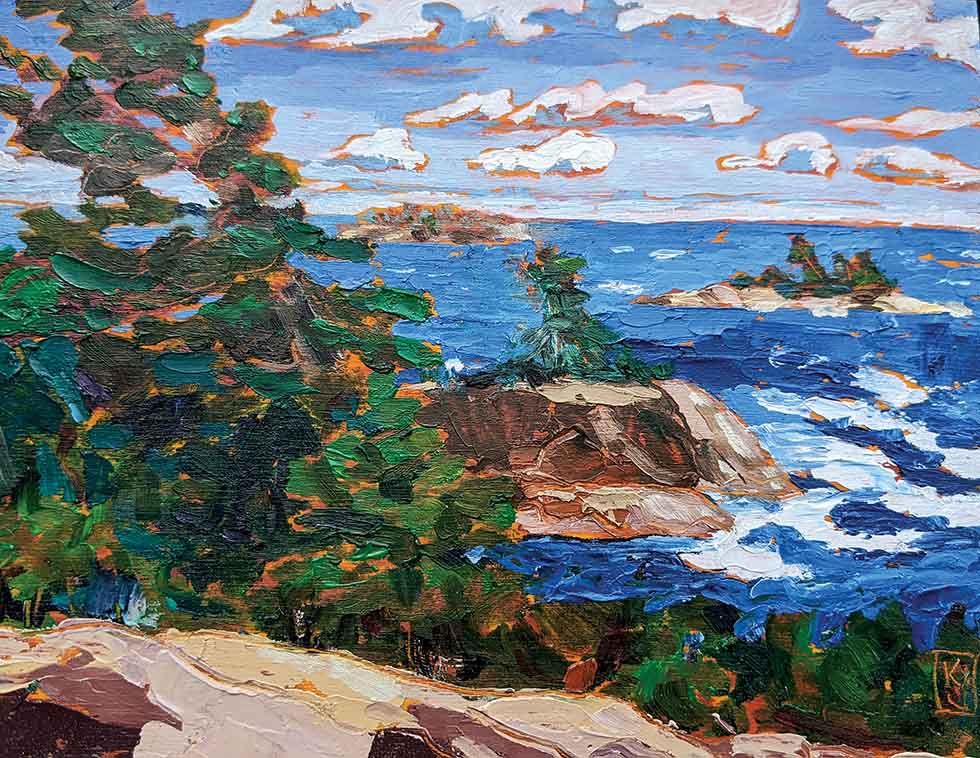
South of Twelve Mile, Georgian Bay, 8″ x 10″ oil.
Never one to let the grass grow beneath her feet, she went from Bella Bella to London, England, where she lived for a year practicing art through teaching. But B.C. had found its way into her heart and imagination, and when she returned to Canada it was to Quadra Island, a ferry ride from Campbell River on Vancouver Island’s eastern shoreline. “I taught there with the Campbell River School Board for a number of years, working with First Nations kids’ in the kindergarten program, and then moving to the alternative education program where I was the liaison with the community, still practicing art through teaching.”
Jones says she always had clear objectives for her life: to not work in the traditional school system but teach creatively; to pursue the arts, live a creative life, and maintain lifelong friendships; and to feel completely secure in her family as the anchor and heart of her life. Yet, she says there wasn’t a Master Plan, per se. She was always open to opportunities and seeking the path less travelled. And life can have unexpected, even cruel ways of presenting those paths. In her 40s, Jones was widowed, and life ultimately led her back to Ontario.
“I moved back about 15 years ago and married my sweetheart. I had reconnected with Phil, who I’d dated in first year university or something when we’d worked together at a girls’ and boys’ camp. His family cottage on Georgian Bay had been in the family for more than 65 years. When I first moved in, we just had wood heat and the wind would rattle through the floorboards in winter, but we dug a basement and put on another level and it’s a proper home now,” she says, laughing.
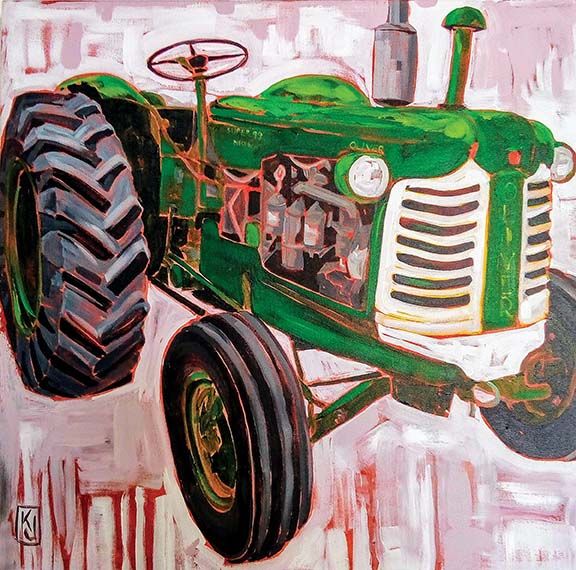
Left: Oliver, GNE, 36″ x 36″, acrylic.
She’s made a home for herself at Tremont Studios, too, where her studio is open to the public. “When people visit me at the Tremont, they often ask how long it takes me to finish a piece, and I kind of have this answer that I say, which is that it takes a lifetime to get to this point. It might take me a week or ten days to do this painting, but I wouldn’t be able to do it without my life experiences—the travel, the living in remote locations, the appreciation for nature, the trip with my husband on our boat to escort the Keewatin, it all adds up to a point where you paint. I don’t want that to sound trite, but it really is a culmination of my whole life experience to this point.”
Jones’ ship paintings and landscape smalls are available through Butter Gallery and on display at Sol Restaurant in Collingwood, and her studio at The Tremont Studios is open to the public. Additionally, her work is available in the annual online Ojibway Club Art Show.
Inside Out, featuring Jones’ paintings and pottery alongside the work of five other female artists, opens Friday April 26th at Nottawa General.
Kaz Jones is on Instagram @kaz.jones.art902
Available work is found on the Butter Gallery website under Artists/Kaz Jones.
